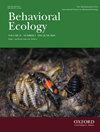种间和种内雌性行为可塑性驱动两种蒺藜的时间生态位分离
IF 2.2
3区 环境科学与生态学
Q2 BEHAVIORAL SCIENCES
引用次数: 0
摘要
时间生态位隔离是减少对共享资源竞争的一种方法。具有重叠空间生态位的物种往往表现出可塑性,可以利用不同的活动时间来减少与其他物种的竞争和干扰。在许多食草动物中,尤其是生活在食物资源中的食草动物,对食物的竞争较小,但其他选择性力量会促使它们在不同的时间段进行不同的活动。生殖干扰,即不同物种个体在获取配偶过程中的相互作用,可能就是这样一种驱动力。生殖干扰是共生面粉甲虫 Tribolium castaneum 和 Tribolium confusum(鞘翅目:Tenebrionidae)之间生态位隔离的强大驱动力。然而,大多数关于面粉甲虫的研究都评估了其他可能较弱的选择性力量,如资源竞争。在此,我们旨在描述该物种的高峰活动时间及其在受到可能的生殖干扰线索时的可塑性。我们使用了一种两个物种共有的合成聚合信息素作为潜在生殖干扰的线索。我们比较了雌雄之间的时间生态位可塑性,因为已知生殖干扰主要会降低雌性的适应性。我们发现,两种生物的活动时间都与内源时钟有关,而且雌雄生物的高峰活动时间和活动水平也不尽相同。然而,一旦接触到聚集信息素,只有雌性才会改变其活动时间,使之与同种雄性的活动时间一致,从而比雄性表现出更强的可塑性,以减少生殖干扰。这些发现表明,聚合信息素在生态位隔离过程中发挥了重要作用。本文章由计算机程序翻译,如有差异,请以英文原文为准。
Inter- and intraspecific female behavioral plasticity drive temporal niche segregation in two Tribolium species
Temporal niche segregation is a way to reduce competition over shared resources. Species with overlapping spatial niches often show plasticity and can use different activity times to minimize competition with and disturbance by other species. In many granivores, especially those living in their food resources, there is low competition over food, but other selective forces can drive distinct temporal activity times. Reproductive interference, that is, the interaction between individuals of different species during mate acquisition, can be such a driving force. Reproductive interference is a strong driving force for niche segregation between the co-occurring flour beetles Tribolium castaneum and Tribolium confusum (Coleoptera: Tenebrionidae). Nevertheless, most studies on Tribolium spp. evaluated other selective forces, such as resource competition, which are potentially weaker. Here, we aimed to characterize the species’ peak activity time and its plasticity when exposed to a possible reproductive interference cue. We used a synthetic aggregative pheromone, shared by both species, as a cue for potential reproductive interference. We compared temporal niche plasticity between the sexes because reproductive interference is known mainly to reduce the female’s fitness. We found that both species’ activity times were hard-wired to an endogenous clock and that the sexes differed in their peak activity time and activity level. However, once exposed to the aggregation pheromone, only females shifted their activity time to match that of conspecific males, hence expressing more plasticity than the males to reduce Reproductive interference. These findings suggest an important role of the aggregation pheromone in the process of niche segregation.
求助全文
通过发布文献求助,成功后即可免费获取论文全文。
去求助
来源期刊

Behavioral Ecology
环境科学-动物学
CiteScore
5.20
自引率
8.30%
发文量
93
审稿时长
3.0 months
期刊介绍:
Studies on the whole range of behaving organisms, including plants, invertebrates, vertebrates, and humans, are included.
Behavioral Ecology construes the field in its broadest sense to include 1) the use of ecological and evolutionary processes to explain the occurrence and adaptive significance of behavior patterns; 2) the use of behavioral processes to predict ecological patterns, and 3) empirical, comparative analyses relating behavior to the environment in which it occurs.
 求助内容:
求助内容: 应助结果提醒方式:
应助结果提醒方式:


